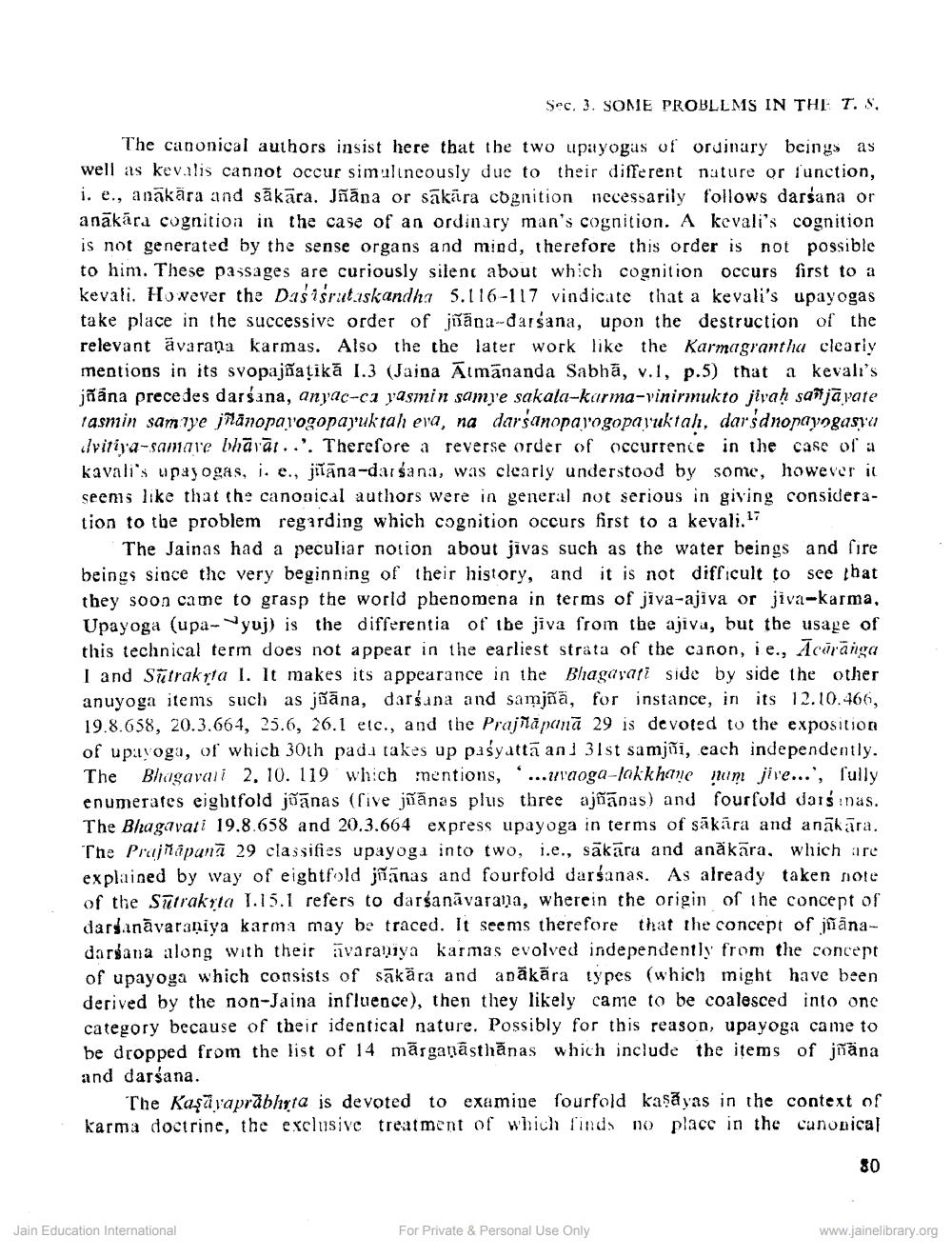________________
Sec. 3. SOME PROBLEMS IN THE T. S.
The canonical authors insist here that the two upayogas of ordinary beings as well as kevalis cannot occur simultneously due to their different nature or function, i. e., anākāra and sākāra. Jāna or sakāra cognition necessarily follows darsana or anakara cognition in the case of an ordinary man's cognition. A kevali's cognition is not generated by the sense organs and mind, therefore this order is not possible to him. These passages are curiously silent about which cognition occurs first to a kevali. However the Dassrutaskandha 5.116-117 vindicate that a kevali's upayogas take place in the successive order of juana-darśana, upon the destruction of the relevant ävarapa karmas. Also the the later work like the Karmagrantha clearly mentions in its svopajñatikā 1.3 (Jaina Atmananda Sabha, v.1, p.5) that a kevali's jána precedes darśana, anyac-ca yasmin samye sakala-karma-vinirmukto jivaḥ saħjāyate Tasmin samaye jäänоpayogopayuktah eva, na darsanopayogopayuktah, darsdnopayogasya dvitiya-samaye bhāvāt... Therefore a reverse order of occurrence in the case of a kavali's upayogas, i. e., jana-darśana, was clearly understood by some, however it seems like that the canonical authors were in general not serious in giving consideration to the problem regarding which cognition occurs first to a kevali.
The Jainas had a peculiar notion about jivas such as the water beings and fire beings since the very beginning of their history, and it is not difficult to see that they soon came to grasp the world phenomena in terms of jiva-ajiva or jiva-karma, Upayoga (upa-yuj) is the differentia of the jiva from the ajiva, but the usage of this technical term does not appear in the earliest strata of the canon, ie., Acoränga I and Sutrakyta I. It makes its appearance in the Bhagavart side by side the other anuyoga items such as jääna, darśana and samja, for instance, in its 12.10.466, 19.8.658, 20.3.664, 25.6, 26.1 etc., and the Prajnapana 29 is devoted to the exposition. of upayoga, of which 30th pada takes up paśyatta an! 31st samji, each independently. The Bhagavali 2. 10. 119 which mentions,...uvaoga-lakkhane num jive...", fully enumerates eightfold joanas (five jüanas plus three ajanas) and fourfold darsinas. The Bhagavati 19.8.658 and 20.3.664 express upayoga in terms of sakara and anākāra. The Prajnapana 29 classifies upayoga into two, i.e., sākāra and anakāra, which are explained by way of eightfold jänas and fourfold darśanas. As already taken note. of the Sutrakyta 1.15.1 refers to darśanavarana, wherein the origin of the concept of darianavaraniya karma may be traced. It seems therefore that the concept of janadarsana along with their avarauiya karmas evolved independently from the concept of upayoga which consists of sākāra and anākāra types (which might have been derived by the non-Jaina influence), then they likely came to be coalesced into one. category because of their identical nature. Possibly for this reason, upayoga came to be dropped from the list of 14 mārgaṇāsthānas which include the items of jñāna and darsana.
The Kaşayaprabhrta is devoted to examine fourfold kasayas in the context of karma doctrine, the exclusive treatment of which finds no place in the canonical
Jain Education International
For Private & Personal Use Only
80
www.jainelibrary.org




